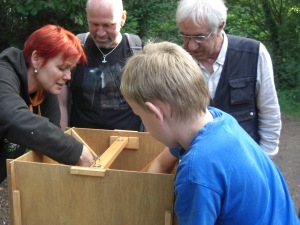It was fantastic to see so many people at Railway Fields for the Friends’ first ever moth event this weekend. A big thank you to Michael Hammerson, who shared his moth expertise and identified the moths we caught in our trap.
Moths and their caterpillars are a vital part of the ecosystem; they provide food for birds, bats, frogs, spiders and other creatures as well as playing an important role as plant pollinators. However, they are often overlooked, perhaps because many only come out at night or because they are thought of as pests (in fact only a few of the 2,500 different types of moth eat clothes). Thanks to a small grant from Haringey Council, the Friends bought a moth trap to help us find out more about the moths that live at Railway Fields.
On Friday evening we set up the moth trap – a wooden box with a light that attracts the moths. They fly or fall into a narrow gap between two sloping perspex sheets below the bulb – they are unharmed but can’t fly out again. Some empty egg boxes inside the trap give the moths a place to hide away until their release.
It was exciting to open the trap the next morning and find the following:
- Common footman (x 10)
- Heart and dart (x3)
- Eudonia lacustrata (x4)
- Buff ermine (male)
- Willow beauty
- Bee moth (the larvae of this moth eat the combs in bee and wasp nests)
- Riband wave
- Chrysoteuchia culmella (a type of grass moth)
- Clepsis consimilana
- Spilonota ocellana
This is just a snapshot of moth life at Railway Fields, as different moths are active at different times of year. We also learned that some moths aren’t attracted to light so are unlikely to be found in the trap. Others, like the colourful cinnabar moth, fly during the day.
Once we had had a good look at the catch and consulted the reference guides to identify some of the trickier species, the children helped us to free the moths back to their natural habitat.
For more moth facts, or to find out how to attract and look at moths in your garden, visit the Moths Count website.



Thanks for the marvelous posting! I quite enjoyed reading it, you can be
a great author. I will make sure to bookmark your blog and may come back very soon. I want to encourage you to ultimately continue your great
job, have a nice morning!